10 Biggest Cricket Stadiums in the World- Blogs Year

World Biggest Cricket Stadium
The top 10 largest stadiums are located in both Australia and India, which is indicative of the long-standing cricket rivalry between the two nations. Based on the number of spectators they can hold, the stadium sizes are compared. The top 10 cricket stadiums worldwide are listed below.
Here are the following is a list of world biggest cricket stadium, ordered by capacity, as of February 2022. Currently, all grounds with a capacity of 15,000-30000 or more which are the home venue of a club or national team are included. so many cricket ground with a capacity of more than 10,000 are also included.
Also Read: –Top 10 Richest Cricketers in the World
Complete List of 10 Biggest Cricket Stadiums in the World
1. Narendra Modi Stadium, Ahmedabad, India | Biggest Cricket Stadiums in the World
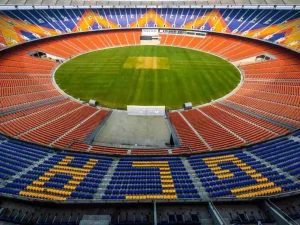
It is one of the few stadiums with a 1,32,000 capacity that uses LED lights within the stadium rather than the more typical tower floodlights. The stadium was initially built in 1983, after which it was destroyed and entirely rebuilt in 2020. For earthquake resistance, the ceiling is made of a PTFE membrane that is lightweight and separate from the seating. The world’s biggest cricket stadium & largest cricket stadium in the world the Narendra Modi Stadium in the Motera area of Ahmedabad this is newly built cricket stadium it is a refurbished stadium Earlier known as the Sardar Patel Stadium. This is very impressive with new drainage system can make the ground match. It was inaugurated in 2020 in lock down and has the capacity to hold approx 135,000 spectators, It is in history making it the biggest cricketing venue ever over the world .
Additionally, because the building doesn’t need any columns, spectators can see the stadium well from every angle. The stadium’s lower levels are intended to be used for smaller events, and it connects via skywalk to the closest metro station to reduce traffic.
2. Melbourne Cricket Ground, Australia’s Melbourne

It can accommodate 1,00,024 people and is referred to locally as “The G.” It was constructed in 1853 and has played host to several significant sporting occasions, including the 1992 and 2015 Cricket World Cups, the Commonwealth Games, and the Summer Olympics in 1956. Awe-inspiring views of the city and Yarra Park can be seen from the stadium.
Three large glass atriums leading to the three entrances are covered by a glass and metal roof. The enlargement of the Australian Gallery of Sports, which is now a component of the National Sports Museum and includes interactive technology, is a new element of the refurbished stadium.
3. Eden Gardens, Kolkata, India | Biggest Cricket Stadiums in the World
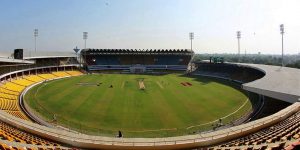
It is known as “the Mecca of Indian cricket” because it was built in 1864 and is the country’s first cricket venue. It has held both the Asia Cup and World Cup and can accommodate 66,349 spectators.
The stands were given the names of illustrious Indian cricketers and warriors, and the stadium was named for the Eden sisters of Lord Auckland, India’s then-governor-general.
4. Shaheed Veer Narayan Singh International Cricket Stadium, Raipur, India
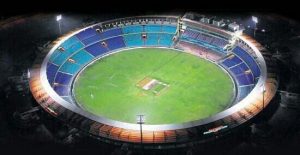
It has a 65,000 seat capacity and was constructed in 2008. It serves as Delhi Daredevils’ second home field in the Indian Premier League. Veer Narayan Singh Binjhwar, a landowner from Sonakhan who led the 1857 war for Indian independence in Chhattisgarh, is honoured by having the stadium bear his name.
Despite not having yet hosted an international event, it has recently upgraded amenities and is regarded as one of the top sports grounds in the nation.
5. Perth Stadium, Perth, Australia | Biggest Cricket Stadiums in the World

Perth is a multifunctional building with 60,000 seats that was constructed in 2017. Numerous significant sporting leagues, as well as major cultural events and concerts, have all taken place there. Its proximity to the Fremantle sea allows users to take use of both the view and the breeze to beat the oppressive heat.
The stadium was a project that revitalised the city’s wasteland and transformed it into a busy park and cultural centre.
6. Rajiv Gandhi International Cricket Stadium, Hyderabad, India
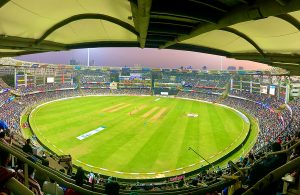
It can hold 60,000 fans and is the home of Sunrisers Hyderabad of the Indian Premier League. The presence of a temple within this stadium to ensure that the home team wins serves as compelling evidence that Indians see cricket as a religion. According to Vastu Dosham, the stadium was believed to be cursed for the team because of the wrong alignment of the locker rooms (Hindu architectural design outlines).
The fact that the team almost always triumphs in their stadium suggests that mending that and building a temple changed their luck.
7. Greenfield International Stadium, Trivandrum, India | Best Cricket Stadium in the World
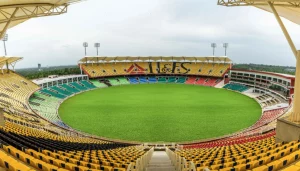
It was India’s first outdoor DBOT style stadium when it was built in 2014 and has a 55,000 capacity. This suggests that the Kerala Cricket Association is leasing the field from the private company Kariavattom Sports Facilities Limited for the first 15 years (governing body).
Along with a spa, a clubhouse, and facilities for indoor games like volleyball, badminton, and table tennis, it also features an Olympic-sized swimming pool.
8. Jawaharlal Nehru Stadium, Kochi, India
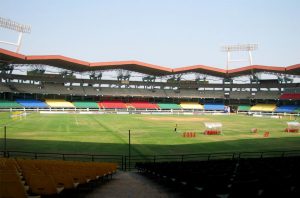
It is a multi-use stadium with a capacity of 55,000 spectators that was built in 1966. The stadium’s unique feature is its roof which is made of high corrosion and oxidation resistant Galvalume sheets with M.S. trusses.
Furthermore, the roof holds the potential of housing solar panels to help power the stadium facilities, which will be installed soon.
9. DY Patil Sports Stadium, Navi Mumbai | Best Cricket Stadium in the World

Built-in 2008, DY Patil Stadium also has a capacity of 55,000 spectators and was designed by Hafeez Contractor. Since its opening, the stadium has hosted multiple IPL matches and is the home to the IPL team Mumbai Indians. It has also hosted notable cultural events such as concerts.
The unique feature of the stadium is that it has a cantilevered full wing roof, which ensures an unobstructed view for all. The roof is made of a fabric imported from Germany.
10. Adelaide Oval, Adelaide, Australia

It was built in 1871, with a spectator capacity of 53,583. The stadium has grown to become a landmark in urban design and an icon for sports architecture in Australia. The site was an existing social and cultural buzzing that has been enhanced since the stadium’s construction.
The stadium is perceived as three pavilions, each of which respond to the surrounding site, the gaps between the pavilions provide views and connection to its context to break the conventional introverted nature of a stadium.








